
The other week, I awoke to the smell of cedar and the sound of an axe splitting wood. Looking outside, the neighbor was preparing for winter the old-fashion way. For many of us, nothing says winter more than a fire roaring in the fireplace. The end of summer and beginning of fall is the ideal time to start your stockpile while the weather is still dry. If you are looking to chop, or even buy, logs to keep you toasty through the chilly months, here are a few words of advice from the Encyclopedia of Country Living dame, Carla Emery:
- Permission: Anywhere outside your own property, you need permission before you cut firewood. The U.S. Forest Service and the Bureau of Land Management(B.L.M.) look after a lot of the public woods and will, in many areas, readily grant you a permit to cut 10 cords or so, if you give them $10. You can get your permit at any Forest Service District Office or at any B.L.M. office.
- Choosing Wood: Softwoods, such as pine and cedar, have a coarse fiber that burns quickly. They make good kindling. Pine is very pitchy. You can tell a pitchy wood in the fire because it does a lot of noisy popping. For a long-term steady fire, especially for oven-baking, hardwood such as oak, beech, ash, maple, and cherry are nicest.
- More on Choosing Wood: It's ideal to find a snag (dead tree) that still has bark and branches on it. The bark and branches show that it hasn't been dead too long and hasn't had time to rot. Or a blow-down with bark and branches will be all right if it's not too wet. Use green wood (live wood) only if you have cut it and let it season at least 6 months to dry out well.
- Chain saws: Hang on to your chain-saw warranty. They break down a lot, especially the cheaper brands.
- Chopping Wood: If you're right-handed, start the ax out back of your right shoulder behind your head with your back arched backwards just a trifle (or you can alternate shoulders with every swing) and then bring it forward and down, moving your shoulder and chest forward at the same time. Try to hit your block of wood right in the center. If your wood doesn't split from the center you can try taking slabs off the edge awhile before you tackle the heart.
- Kindling: You need really dry wood for kindling. Wood on the green side burns okay in a big fire, but it makes terrible kindling because it is so damp.
- Storing Your Wood: Cut and store under shelter inside a shed or at least under a tarp. If you have 2 buildings close together you can roof over the gap with tin sheets or something cheap, put a back on it, and have a very adequate woodshed. Split your wood before stacking; this increases the exposed surface area and reduces drying time. Stacking the wood in alternate directions row by row further helps the drying process.
- Wet Vs. Dry Wood: Learn to recognize dry wood by sight and sound. If there are cracks in the wood, it's dry. If it gives a high-pitched ring from a thump, it's dry (wet wood gives a low-pitched thudding sound).
- Pollution: Wood stoves make a considerable contribution to an area's smog if there are lots of them in a small area. Air inversions and still air can keep that pollution hovering right over you. if you want to burn wood, be considerate of others. And if you're in an area with regulations, obey the laws.








No comments:
Post a Comment